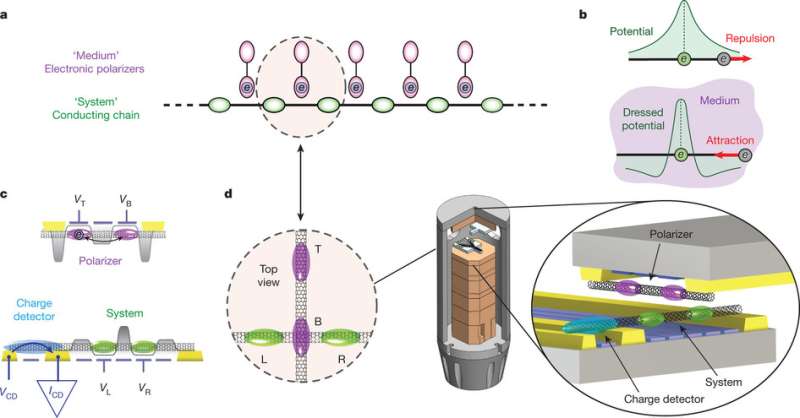July 21, 2016 report
A way to get electrons to attract each other using other electrons

(Phys.org)—A team of researchers at the Weizmann Institute of Science in Israel, with assistance from another at Freie Universität Berlin in Germany has found a new way to get electrons to attract one. In their paper published in the journal Nature, the team describes the technique they used and the ways their results might prove useful. Takis Kontos with Ecole Normale Supérieure in France offers a News & Views piece on the work done by the team in the same journal issue and in addition to outlining their work offers some history on its development by others in the field.
Getting electrons to attract each is a big part of superconductivity, but unfortunately, due to the need for extremely cold temperatures most such materials have not proved to be of practical use. What scientists would really like to find is a material that could be a superconductor at room temperature and one promising avenue of research has been attempting to realize a theory proposed by William Little half a century ago—he suggested it might be possible to get electrons to attract one another by using the repulsion of other electrons. In this new effort, the researchers have attempted to prove this theory correct by using carbon nanotubes placed near one another.
Their experiment consisted of coaxing just two electrons into a carbon nanotude and a polarizer in the form of two energy wells in a second carbon nanotube. They then positioned the two nanotubes perpendicular to each other, with one over the top of the over forming a cross, though they were not allowed to touch—one was kept approximately 100 nanometres away from the other. At that distance, the researchers confirmed that the electrons became attracted to one another.
In theory, the team notes, it should be possible to create a superconductor using their method—unfortunately, creating an entire crystal, or even a short chain of material in such a way, is likely to be exceedingly difficult. Still, Kontos suggests that it could be used to create a quantum simulator which could be added as yet another tool for researchers in the field.
More information: A. Hamo et al. Electron attraction mediated by Coulomb repulsion, Nature (2016). DOI: 10.1038/nature18639
Abstract
One of the defining properties of electrons is their mutual Coulomb repulsion. However, in solids this basic property may change; for example, in superconductors, the coupling of electrons to lattice vibrations makes the electrons attract one another, leading to the formation of bound pairs. Fifty years ago it was proposed that electrons can be made attractive even when all of the degrees of freedom in the solid are electronic, by exploiting their repulsion from other electrons. This attraction mechanism, termed 'excitonic', promised to achieve stronger and more exotic superconductivity. Yet, despite an extensive search, experimental evidence for excitonic attraction has yet to be found. Here we demonstrate this attraction by constructing, from the bottom up, the fundamental building block8 of the excitonic mechanism. Our experiments are based on quantum devices made from pristine carbon nanotubes, combined with cryogenic precision manipulation. Using this platform, we demonstrate that two electrons can be made to attract each other using an independent electronic system as the 'glue' that mediates attraction. Owing to its tunability, our system offers insights into the underlying physics, such as the dependence of the emergent attraction on the underlying repulsion, and the origin of the pairing energy. We also demonstrate transport signatures of excitonic pairing. This experimental demonstration of excitonic pairing paves the way for the design of exotic states of matter.
Journal information: Nature
© 2016 Phys.org




















